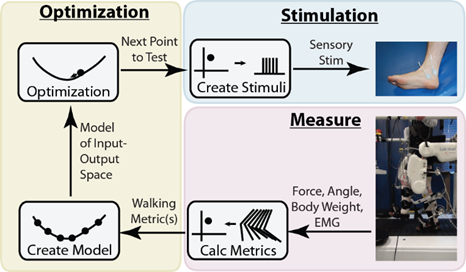In uninjured individuals, spinal neurons integrate sensory feedback from the legs with descending commands from the brain to produce walking. After severe spinal cord injury (SCI), spinal neurons are mostly disconnected from the brain, leading to the loss of voluntary locomotion. However, the injury leaves the sensory connections to neurons in the lower (sub-lesional) spinal cord intact. The sensory connection generally remains sufficiently intact for sensory input to recruit the spinal neural networks to generate a walking pattern, including the central pattern generator (CPG).
Sensory stimulation has been found to help many of those with spinal cord injury walk better, but it is generally not controlled precisely (e.g. manually hand-triggered) or optimized to specific individuals with spinal cord injury.
Human SCI produces a wide range of outcomes, depending on the level of the injury (e.g. Thoracic level 6), the completeness of the injury (e.g. AIS A – both sensory and motor complete), the time/training since injury, and the individually unique way in which the spinal cord reorganized after the injury. All of these combine to make it difficult to treat spinal cord injuries as a single group, requiring a more custom approach to individual subjects.
The objective of this project is to maximally improve the walking pattern with artificial sensory input in individual SCI subjects. During walking, sensory stimulation will start at different gait phases, stay on for variable duration, with variable stimulus frequency. The group is using a novel closed-loop optimization approach to determine the best input. In addition to producing an optimal stimulation pattern, this study will also produce detailed quantitative maps of sensorimotor processing, which may provide insight into neurophysiological changes that occur after SCI.



